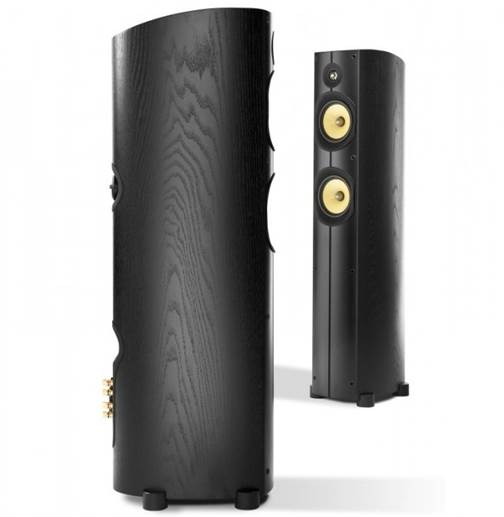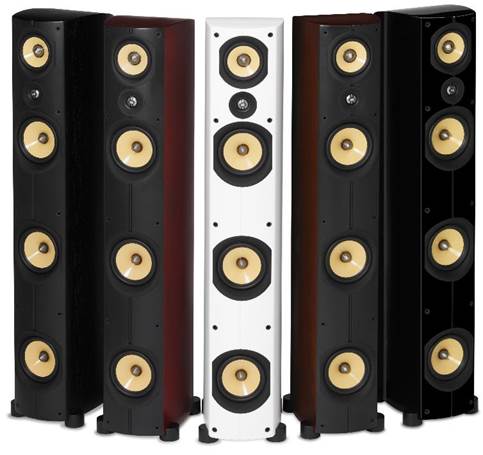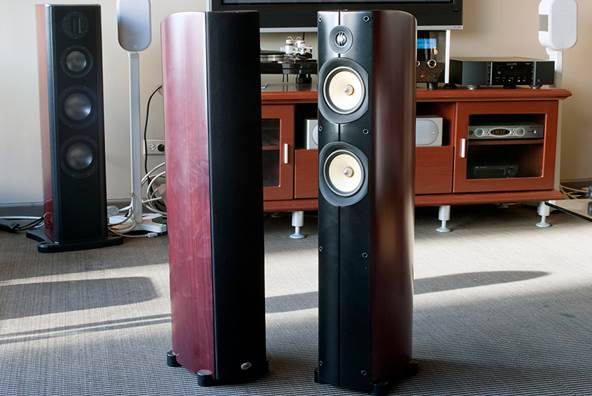Paul Barton, the designer, stated: “With T, I incorporated
our latest design know how into a taller cabinet, for deeper bass, a larger
soundstage and increased power handling.” I think he was successful in all of
these respects judging by the performance of the speaker on the end of my system
combination. The Imagine Ts have a fruity, quite rich bass response and a
vivid, enthusiastic high frequency band that may come from being voiced for the
American market. They steer clear of being criticized for having a boom and
tizzy response by a small, albeit discernible margin, but they are certainly
lively and deliver plenty of energy at the far ends of the audio frequency
spectrum.

They also produce
often quite vivid, well-dimensioned sound stages filled with credible images of
performers and their instruments.
They also produce often quite vivid, well-dimensioned sound
stages filled with credible images of performers and their instruments. They
create a realistic image with excellent scale of the Utah Symphony Orchestra
playing the challenging Americus by the avant-garde composer Edgard Varese,
bringing out a wealth of detail from the band, in particular the smaller
percussion instruments and the brass section. There is a rewarding sense of
scale that delivers a fine, three dimensional sound stage with a convincing
feeling of acoustic space and genuine air around the instruments in the
orchestra.
The Imagine creates a similar sense of space and depth on
much smaller-scale music, for example, that of the acoustic roots power-trio
Vivid Curve playing on their magnificent Live at Edgefield recording. The
speaker seems to excel at portraying the didgeridoo and the wonderful harmonic
structure that Jeff Cooper manages to persuade the instrument to produce. The
full-bodied, powerful presentation is not wholly consistent until the speaker
has had the chance to warm up thoroughly as the acoustic guitar does not always
project from the sound stage with the same vitality as it can do on other
loudspeakers. Importantly though, once the speaker has fully run-in, the
performance displays vigor and is rhythmically engaging.
The PSB seems to relish small instrumental combos and does a
grand job of portraying Bill Frisell’s Pipe Down from his East, West album. It
is particularly successful recreating the startling dynamics of the drum kit,
which rockets forward from the rear of the sound stage. Frisell’s guitar
dynamics are equally assertive and blessed with acute leading-edge information.
The speaker presents his unique tone and dynamic contrasts capably, and the guitar
sounds colorful, faithfully vibrant and attacking. All in all, the presentation
is involving and wholly engaging – it makes the music fun and ensures that you
want to listen further.

The finishing and
attention to detail in their construction is very impressive
So the PSB fares well with classical, jazz, and roots music.
But how does it cope with more contemporary fare? The simple answer is that it
heartily enjoys music with so much as a sniff of a leading edge – be it
acoustic, electric or any other genre. It rocks capably and assuredly with
artists as diverse as Rodrigo y Gabriela, James McMurtry, Jeff Beck, Robert
Plant and Alison Krauss, and Robbie Robertson. The titanium HF unit seems to
emphasize the attack of snare drum beats and also improves the timing of bass
guitar quite noticeably. The PSB gracefully through Rodrigo y Gabriela’s Take
5from the Re-Focal bum, relishing the attack of their acoustic guitars and
their percussive playing. The speaker also handles the more subtle challenge of
Robert Plant and Alison Krauss’ vocal harmonies on Please Read the Letteron the
24/96 rip of Raising Sand, rendering their voices like those of angels in the
pub on pay day.
In short, the PSB Imagine T is well worth seeking out to audition
if you are looking for a $2,100 floor stander that will perform satisfactorily
with most types of music – even left-field stuff such as Varese and
didgeridoo-toting power trios. Its only drawback is that its characteristic
sound seems voiced more for vivid tastes and you will doubtless find some music
with which it sounds unsubtle, even a little obvious and uncouth at times. A
careful set-up can take this to some extent and I am sure that many will enjoy
its vivacious sound.

In short, the PSB
Imagine T is well worth seeking out to audition if you are looking for a $2,100
floor stander that will perform satisfactorily with most types of music
How it compares
The Imagine T has a voicing that has a tendency to emphasize
the frequency extremes. Careful positioning can help ameliorate this, with
judicious toe-in taking a little of the sting out of the HF response and
cautious room-positioning with respect to boundaries and port-bunging helping
to reduce undue low frequency reinforcement.
The Neat Motive SX1s are slightly more costly floor
standers, but have a balance and voicing of even more expensive models. They
provide depth and bass power, but exhibit greater control than the PSBs. They
are also much sweeter-sounding at the top of the range yet are just as
detailed.
Our verdict
·
Sound quality: 4.5/5
·
Value for money: 5/5
·
Build quality: 5/5
·
Ease of drive: 4.5/5
·
Like: Lively, vital character; ease of drive; its fine finish
·
Dislike: Unsubtle sound; tweeter can be brittle and ‘obvious’
·
We say: A competitive speaker at the price, but it needs
balancing with some controlled-sounding electronics
·
Overall: 4.5/5
|
Details
·
Product: PSB Imagine T
·
Origin: Canada/China
·
Type: Floor standing, three-way loudspeaker
·
Weight: 16.6kg
·
Dimensions (W x H x D): 214 x 936 x 325mm
·
Features : Quoted power handling: 200W; Quoted frequency
response: 38Hz - 23kHz (+/- 3dB); 25mm titanium dome tweeter; 2x 133mm
clay/ceramic mid/bass driver
·
Distributor: Seven oaks Sound and Vision
|